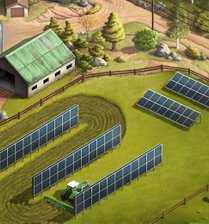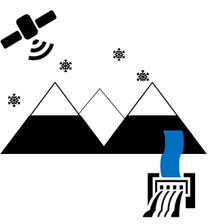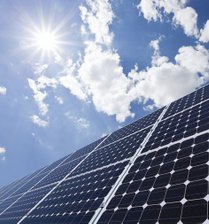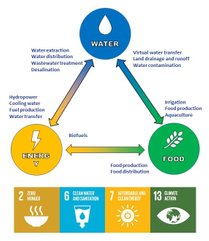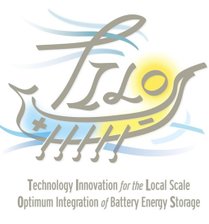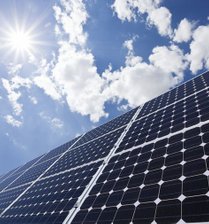Opti-CE
Optimization of Clean Energies
Photo by Jason Blackeye on Unsplash
The Opti-CE model in its different time and spatial resolutions and configurations has been developed for different national and international projects focusing on renewable energy and anaegey storage integration and water-food-energy nexus.
Evaluation of the first agrivoltaic system in Sweden
The aim of this project is to carry out a feasibility study of how agrivoltaic systems, photovoltaic systems that combine electricity production and farm activities, can increase the economic viability of photovoltaic systems in Sweden. Agrivoltaic systems presents several advantages over traditional ground-based photovoltaic systems: higher electricity yield, crop yield and water savings as compared to common practices. The combination of revenues can lead to high land use efficiency and shorter payback time. This project will address the topic of agrivoltaic systems using a holistic approach that combine three different macro-areas (energy, food and water) with an interdisciplinary research group. The research activities will focus on feasibility test at a farm nearby Västerås, simulation and optimization model development, and development of novel key economic performance indicators. The results of this project will boost the photovoltaic market and research activities in Sweden.
SnowSat-an AI approach towards efficient hydropower production
Snowmelt is an important source for hydropower production, which accounts for about 40% of the total electricity production in Sweden and will play an even more important role in the future Swedish energy system. Spatially distributed and temporally dynamic information on snow amount are highly valuable for the planning of hydropower sector and flood risk assessments. However, accurate depiction of total snow amount remains one of the biggest challenges. Inaccurate quantification of the snow storage upstream of hydropower dams leads to water spills during the snow melting periods and thus significant losses of potential hydraulic energy. Remote sensing provides a great tool for large-scale and dynamic snow monitoring. The big data generated by satellite observations combined with the development of artificial intelligence (AI) and Internet-of-Things (IoT) technologies offers great opportunities for a better understanding of snow conditions. In this project, the overall goal is to use AI and IoT technologies for improving the estimation of snow water storage in Sweden from satellite observations. The proposed solution will lead to improved management of the hydropower sector, increased hydropower production up to 10% and enhanced societal preparedness to extreme weather events, which will contribute to Sweden’s zero net-emission goal and help the society develop better mitigation and adaptation strategies to climate change.
HyCoGen: System perspective for efficient production and use of hydrogen in connection to district heating
This project takes a system perspective on possible collaboration between variable electricity production and storage options in connection to district heating production. The main purpose is to utilize excess heat that arises during energy conversion for storage.
A Gridded Water-Food-Energy Nexus Management System for Sweden
The aim of this pre-study is to build a pilot but comprehensive WFE tool for Sweden that builds on SWEDIMS (SWEDish Irrigation Management System) by using the spatially explicit climatic data generated by SMHI.
Towards An Optimal Irrigation Management System from the Water-Food-Energy Nexus Perspective
The aim of this pre-study is to build a pilot Water-Food-Energy (WFE ) Nexus irrigation management system for Sweden, called SWEDIMS, by using the spatially explicit climatic data generated by SMHI.
Self-sufficient residential area in an urban environment - energy analysis and optimization
The innovative YEAH concept proposes a self-sufficient residential area in an urban environment that is not connected to electricity grids, district heating or municipal water and sewage. The concept can contribute to meeting the goals of Swedish and European energy policy. This research project (which is an extended feasibility study) aims to find out if this is technically and economically realistic. The work includes 1) inventory of the energy system's key components, its investment and maintenance costs, etc .; 2) further development of a simulation model for optimizing energy and economy for the two housing types intended in a first demonstration of the YEAH concept; and 3) a construction of the model into a residential area where Buildings are connected and simulated together. The results are compiled in a scientific publication and form the basis for a forthcoming pilot project application to build a completely self-sufficient residential area in Jönköping.
Improved calculation of PV power generation in Sweden
High latitude and low electricity price in Sweden make accurate prediction of photovoltaic (PV) system energy yield fundamental. The project aimed to have access to accurate data for validation of PV software, a PV system network is created at three SMHI weather stations with complete irradiance measurements. To cope with the lack of complete data at other stations, this project aimed to utilize cutting-edge machine learning techniques to generate missing data fundamental for the uses of several software tools. The best PV simulation tool will be recommended. Future foreseen solar radiation for Sweden will be performed to quantitatively analyze the effects of likely climate changes. A map of Swedish PV energy yield is produced, based on STRÅNG irradiance data.
Feasibility of Renewable Energy Integrated with Energy Storage in Buildings
The FREE project was to carry out pilot feasibility of renewable energies integrated with energy storage into municipal, recreational, and industrial buildings. The primary goal was to provide a complete package solution, which can be used for the pilot or demonstration in a real application. The study will also investigate how existing district heating networks can be affected by the integration of renewables, storage system and micro-grid at the end-users.
TILOS
It was a multinational European demonstration and research project with 15 participating enterprises and institutes from 7 European countries (DE, FR, EL, UK, SE, IT, ES). TILOS project aims to demonstrate the potential of local scale energy storage to serve a multi-purpose role within an island micro grid that is in communication with a main electricity grid. The project aims to demonstrate the large-scale RES penetration through an optimum integration of hybrid-RES (Renewable Energy System) (wind and PV) power station, advanced battery storage, distributed, domestic heat storage, and DSM equipment. The project aim will be accomplished by developing and operating an integrated, smart micro grid on the island of Tilos (located at the south-eastern part of the Aegean Sea and being interconnected to a bigger, island-complex electricity system). The picture below shows the multi-perspective approach of TILOS project and the roadmap to market uptake.
iREST - Integrating renewable energies and storage technologies into residential, office and industry buildings: towards near zero energy targets
This project is to integrate renewable energies and storage technologies into residential, office and industry buildings. The study will also investigate how existing district heating networks can be operated in an optimal way considering the integration of renewables and storage system at the end-users. This project is conducted with the real estate building companies, Wallenstam AB and Castellum (Aspholmen) AB, and the energy providers Mälarenergi AB and Göteborg Energi AB.
Future Energy Center
It was a seven-year research profile that started in the beginning of 2013 and is included in the Future Energy Center at Mälardalen University. The project budget is 83 million SEK, of which the Knowledge Foundation has granted 36 million SEK, the cooperating companies have contributed 32 million, and MDH provide the rest of the funding. The profile will strengthen cooperation in the Mälardalen region: these areas constitute national industries for the future which already have a strong base today in the region, and there is also a large commercial interest.
Demonstration and scale-up of photovoltaic water pumping for the conservation of grassland and farmland in China
It was a project funded by SIDA (Swedish International Development Cooperation Agency) about demonstration and scale up of photovoltaic (PV) solar water pumping technology and system for the conservation of grassland and farmland in China. The original collaboration consortium was made of universities, R&D and engineering institutions, training organizations and end-users/industrial partners, including among other the Royal Institute of Technology (KTH), Mälardalen University (MDH), and the Institute of Water Resources and Hydropower Research (IWHR)

